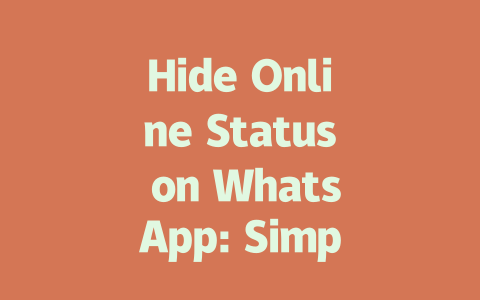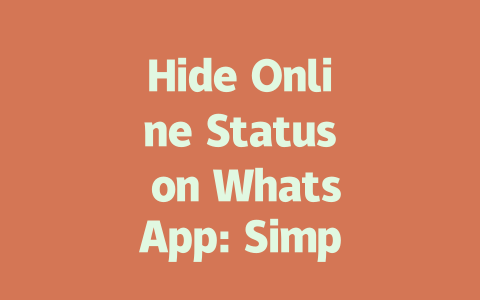You know that feeling when you scroll through your newsfeed, and it feels like every article is either too vague or too specific? I’ve been there too. Keeping up with the latest news in today’s fast-paced world can feel overwhelming. But here’s the thing: it doesn’t have to be this way. Over the years, I’ve experimented with different strategies for staying updated without getting bogged down by information overload. Today, I want to share my personal approach with you—no fancy tools or complicated systems required.
Why does this matter? Because staying informed isn’t just about knowing what’s happening; it’s about understanding how those events impact your life. And if done right, it can even save you time while ensuring you never miss out on something important.
Finding Your Perfect News Source
Let me tell you a quick story. Last year, a friend of mine started her own blog about sustainability. She was spending hours every day trying to stay updated on the latest environmental news. The problem? Most of the sources she relied on were inconsistent, biased, or simply not tailored to her needs. After some digging, I helped her narrow down her list to three key websites: The Guardian, BBC News, and Reuters. Guess what? Within weeks, she felt more confident discussing topics related to climate change and waste management—all because she had reliable, trustworthy sources at her fingertips.
So, how do you find your perfect news source?
Ask Yourself These Questions
Here’s why these questions matter: Google’s search robots prioritize content based on its relevance to users. If you’re constantly searching for “latest tech news” but end up clicking articles from random blogs instead of well-known outlets, guess where future searches will point you? Yep, those same low-quality sites. Instead, choose authoritative platforms that consistently deliver high-value content.
For example, according to Google’s official blog, quality content makes readers feel “informed and supported.” So, if you want to ensure your daily dose of news aligns with Google’s expectations, stick with names you recognize—and check them regularly.
Creating a Customized News Feed
Now let’s talk about customizing your experience. Back in the day, we all relied on newspapers or nightly broadcasts. Fast forward to 2025, and the options are endless. But which ones actually work? Here’s what I recommend:
Crafting Effective Reading Habits
Once you’ve identified your go-to sources, it’s time to optimize how you consume that information. Let me walk you through a step-by-step process I use personally:
Step 1: Prioritize Timing
When do you typically check the news? Morning coffee time? During lunch breaks? Understanding when you’re most engaged helps structure your routine effectively. Personally, I scan headlines during breakfast and dive deeper into longer reads later in the afternoon.
Step 2: Skim First, Read Later
Not everything deserves equal attention. Learn to skim efficiently:
If something grabs your interest, bookmark it for later using tools like Pocket or Evernote. Trust me, having a centralized place to store articles prevents forgetfulness.
|
| Tool | Best For | Cost |
|---|---|---|
| Saving articles offline | Free/Premium plans | |
| Evernote | Note-taking + article saving | Free/Premium plans |
Step 3: Reflect on Takeaways
After finishing an article, pause and ask yourself: What did I learn? How might this affect me or others around me? This simple reflection adds depth to your knowledge base.
I once read a piece about advancements in AI technology. At first glance, it seemed technical—but upon closer inspection, I realized it explained potential job shifts due to automation. That perspective shift completely changed how I viewed career planning going forward.
Building Credibility Through Consistent Practice
Finally, building credibility as someone who stays updated takes practice. Don’t rush yourself into consuming every single update under the sun. Instead, focus on quality over quantity. Remember, Google values content that’s both useful and engaging. By applying these tips, you’ll naturally develop habits that align with their standards.
Got any tips of your own? Or maybe there’s a specific topic you’d love advice on. Either way, drop a comment below—I’d love to hear from you!
If someone decides to hide their online status, you’re out of luck trying to track when they’re active. It doesn’t matter if you’re using an iPhone or an Android—once that person disables the visibility of their live updates, it’s completely off the table for you. This feature has been a consistent part of WhatsApp since its early days and shows no signs of changing anytime soon. You might wonder if there’s a loophole, but trust me, the app is pretty tight about this. Whether you’re checking on a desktop, tablet, or phone, the result will be the same: no peeking into their activity.
Now, some people think hiding your own status might mess with how messages are handled, like delays in showing read receipts or delivery confirmations. But that’s not true at all. Even if you’ve hidden your status, WhatsApp still works as usual behind the scenes. So, while you can’t monitor someone else’s presence if they’ve blocked it, your chats remain unaffected. For instance, say you send a message between 5-12 hours after they last used the app—you’ll still get the double tick once they open it, regardless of whether their status is visible to you or not.
# Frequently Asked Questions (FAQ)
Can I hide my online status on WhatsApp for specific contacts only?
Yes, you can hide your online status selectively. By adjusting privacy settings in WhatsApp, you can choose to share your status with everyone, your contacts, or nobody. However, as of 2025, there is no direct option to hide it from specific individuals only.
How long does the “Last Seen” timestamp stay visible after I close WhatsApp?
The “Last Seen” timestamp updates when you last used WhatsApp. If you close the app but leave it running in the background, your status may still appear as recently active. Typically, this timestamp remains accurate until you reopen the app, which could be within a range of 5-12 hours depending on device activity.
Will muting notifications also hide my online status?
No, muting notifications and hiding your online status are separate features. Muting notifications silences incoming messages, while hiding your online status involves adjusting privacy settings. You can do both independently based on your preferences.
Is it possible to check someone else’s online status if they’ve hidden theirs?
No, if someone has chosen to hide their online status from everyone or from you specifically, you won’t be able to see their live status updates. This applies consistently across all devices and versions of WhatsApp up to 2025.
Does hiding my online status affect message delivery or read receipts?
No, hiding your online status doesn’t interfere with message delivery or read receipts. Your contact will still know when their messages have been delivered or read, regardless of whether your online status is visible or not.




